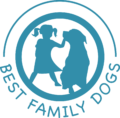Newfoundland Stats!
Breed: Newfoundland
Classification: Working Group
Weight: 110 – 176lbs (50-80 kg)
Height: 68 – 75 cm (27 – 30 inches)
Life Span: 8 – 13 years
Newfoundland is the Nanny Dog From The Classic Peter Pan Story
The Newfoundland dog breed has a calm nature, the strong silent type. The breed has a sweet temper, and is use to working hard. This breed regards children naturally as young lives needing to be nurtured and protected. This breed is very intelligent, and easily trainable. The Newfoundland although very large, is the best family dog for children.
Newfoundland dogs do need lots of outdoor time and long walks to promote good behavior when they are indoors.
The love of being outdoor explorers is just another reason why Newfoundland dogs are the best family dogs for children. Of course dog and child play should always be supervised, whether it is indoors or out.
These dogs are cute as puppies and always gentle. However, this breed can be stubborn, and is generally not recommended for first time dog owners. As cute as they are as puppies, they quickly grow to a great size. Their obedience training needs to start as early as possible and be consistent to achieve the compliant behaviors observed in the following video. Just look at how cuddly this dog can be and how big they can become? You wouldn’t want a Newfie that has not been properly trained. Experience with intelligent and stubborn large breeds is an asset.
An owner experienced with intelligent and stubborn large breeds is an asset for the Newfoundland breed.
Gentle Giants Interact with Their Human Siblings
Newfoundland Dog Breed History: Myth Versus Fact
The truth about Newfoundland Dogs history dates back to the beginning of the 16th century. Portuguese fisherman visited Newfoundland Island in Canada and often brought their mastiff dogs with them. The Canadians living on the island had a large breed dog known as the St. John’s Dog, or “lesser” Newfoundland.
The Newfoundland Dog breed was well suited for the job of assisting the fishermen. The Newfoundland Dog loves water, and can swim well. This breed has a unique dog paddle that moves down and out, more like a modified breast-stroke than the common “doggy-paddle”. The breed also has webbed feet which help the dog propel easily through water. The breed was officially recognized by the American Kennel Club in 1886.
Since the Newfoundland dog breed has a strong affinity for water, the breed has gained a reputation as a rescue dog. To this day, the breed has many stories of being a successful “Life-Guard” in water rescue situations. The dogs are used in Italy to rescue people from the water. Often the dogs must jump from helicopters into the water to reach boaters stranded in the ocean.
Did You Know?
Newfoundland dogs have uniquely designed paws that help them the swim because they have a slight webbing to their toes. This breed has also developed their own swimming technique. They use their front legs in more of a “breast-stroke” pattern than the typical “doggy-paddle” seen in all other breeds.
How To Know If a “Newfie” is Right For You
Newfoundlander dogs make great family dogs for children if you have the experience and commitment to work with them to become part of your family unit. Previous Newfie owners report lots of drooling, licking and grooming as the things that can be a bit of a hassle at times. But overall, the play they provide for children, their love of exploration and adventure, and their sweet and gentle nature makes up for the slobber. These are quiet, loyal dogs for a family that can train them well and love them always.
Newfies Are Meant to Swim!
A True Working Dog Breed
Newfoundland dogs love to have jobs. Some ways in which they are used to help people are:
- Saving swimmers They swim out in water to help save people in too deep, literally, if you are near drowning and conscious, this breed has been known to pull people to safety by letting the person grab onto their thick coat. When someone is not able to help themselves this breed lovingly pulls people to safety on shore keeping their head above water! They have also worked on ships and assisted nautical staff when others have gone overboard.
- Pulling building supplies These dogs have been used to help transport building supplies and equipment, such as lumber, for explorers who go across countries and set up camps and towns as they travel.
- Mail carriers and food relief Newfoundland dogs have also been known to assist with mail transportation to facilitate communication among people and as food relief transporters to deliver food to marginalized populations.
Proof that dogs that work this hard are very intelligent!
Newfoundland Grooming Needs
Newfoundland dogs require a lot of grooming. It is generally recommended to bath them every two to three weeks. They have a double coat which means different textures and layers. Special shampoo, conditioners and tools are required to groom this breed well. Neglect of their coat will lead to matting and skin issues. They often require hair blow drying to dry the coat after bathing. Many people groom their newfie themselves, but you can also use a regular grooming service.
Is The Newfoundland The Best Family Dog For You?
This breed loves the outdoors and has a thriving sense of adventure. Perfect family dog for growing children! They also very gentle when raised with firm boundaries and consistent rules. These large dogs tend to be bratty and stubborn and need motivation-based training as soon as possible to become the calm, sweet adult dogs as in the videos above. Remember the story of Peter Pan and Never-Never Land? The Newfoundland is the same breed as the nanny dog that watched the children in the story before they flew off with Peter Pan!

Newfoundland dogs make great family dogs for children of all ages. They are gentle, kind and docile. They are strong and protective when they have to be. This breed loves to work and takes their “job” very seriously. They are a pleasure to have as a dog in any family.
Do you have a Newfoundland dog in your family?
Resources:
Newfoundland (Newfie): Dog Breed Characteristics & Care
Newfoundland Dog Breed Information


